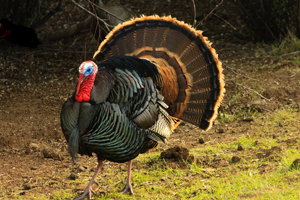Warmer temps are upon us and soon we will be able to chase some spring gobblers, but before heading out there are a few things to do to prepare.
First, read the turkey hunting regulations and purchase the proper licenses and stamps that are required.
You need a place to hunt. For many of us that is the same area year to year, but those new to the sport or looking to increase their odds may want to find new ground.
Private land provides more control of where and when you choose to hunt. If you don’t own hunting land or know someone who does, you still can ask around and often find some good areas. Always ask permission and be courteous to the landowner for the opportunity. Make sure to leave the area the way you found it.
If you are unable to find private land there are many acres of public hunting land that will provide great opportunities at harvesting a bird. Pay special attention to your surroundings and try not to set up near anyone else already hunting the area. Also make sure you are seen by anyone that you notice approaching you while you are hunting.
No matter where you intend to hunt it can always pay off to scout and determine where birds are hanging out on the property. Get out in the area early in the morning and listen for turkeys to start gobbling as the sun comes up. If you are unable to see them, pay attention to which directions they move. They usually will follow similar patterns day after day. It can be much easier to intersect a turkey’s path than to try and call them away from where they want to go.
You’ll want to find a shotgun that you’re comfortable shooting. Practice shooting so you can be confident when a bird approaches while you are hunting. It’s best to pattern your gun with shells (usually a 3- or 3 1/2-inch 4 or 5 shot) you intend on using so you know just what to expect when you pull the trigger.
Try to blend into your surroundings. Either by wearing camouflage clothing and sitting in the brush or against a tree to breakup your outline, or just wearing dark colors and sitting inside a ground blind can work fine. The most important thing is to limit your movement. A turkey’s greatest defense is its eyesight. They can see the slightest movements and will become very alert and retreat if you move as they approach. If you find it hard to hold still, a ground blind can help conceal your movements.
Decoys can either make or break your hunt. I have had times where I used decoys and a tom comes running right in and then I have had other times where they get to the point where they can see the decoy and hangup at a distance waiting for the hen to come to them. There is no foolproof decoy setup but the most common set of decoys seems to be a hen and a jake. This will often get a mature gobbler to come in with the intent to scare off the jake thus bringing the tom into range for a shot.
You can also hunt without a decoy. This can be an advantage when hunting in thicker cover. The gobbler hears your calls but can’t see the hen and he keeps coming in to find her.
There are many calls available for turkey hunting. Most calls are intended to imitate a hen to call in a gobbler, and some use calls that sound like a gobbler. Another call often used is a locator call; these imitate owls, crows, or coyotes and can often get gobblers to shock gobble thus giving away their location. Locator calls can be great for scouting out new areas to hunt, but are not always as effective.
The most common calls used would be slate calls, box calls, and diaphragm calls. Whichever ones you decide to use, make sure to get them ahead of time and practice as much as you can. Box calls can be better for longer range and then the slate and diaphragm calls can be concealed easier as birds get into range.
Turkey calls can be very effective when used correctly, but one of the most come mistakes made by turkey hunters is that they call too much. Once a turkey responds to your call he pretty much knows where you’re at. Every time you call after that and get him to gobble is another time he stops approaching and goes into a strut trying to get you “the hen” to come to him.
There is no fool-proof way to kill a turkey. Sometimes you’ll have one come right in on your very first sit and then the next season you just can’t seem to get them to commit. Sight-in your gun and practice to increase your confidence. Put yourself in a area where there are good numbers of birds giving you lots of opportunity. Conceal yourself the best you can and limit movement to avoid spooking birds. Practice your calling but don’t overcall while hunting.
Good luck hunting and stay safe!






